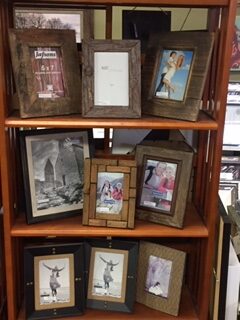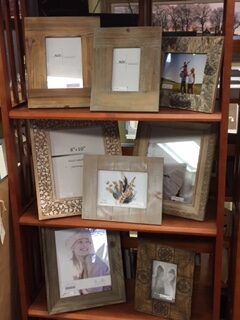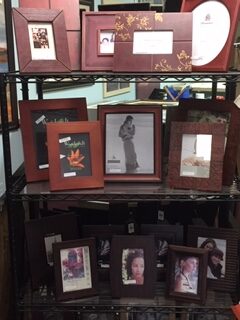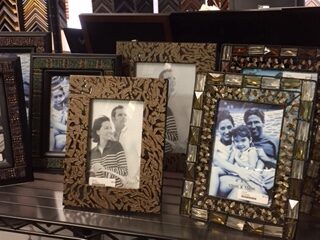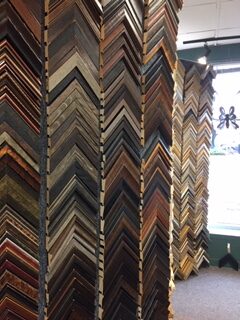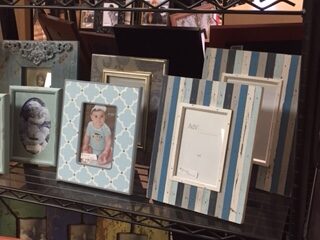We offer design assistance for any project, helping you express your style while displaying your piece to it's best advantage. Our staff have the experience and education to recommend the best material choices for your project. In business since 1986 we have framed everything imaginable from posters to original art, team jerseys to war memorabilia, needle art to children's art and everything between. Each piece is individual and framed on site so your finished project can be displayed with pride. We carry the areas largest selection of frame samples and matting options enabling us to offer you framing solutions for every budget.
Needle art and other textiles deserve special attention when being framed. After the long hours spent creating these works of art, glazing is suggested as a means of protecting needlework from airborne pollutants such as smoke or grease, as well as curious fingers. Glass should never come in direct contact with your needlework. Unless the glass can be separated from the needlework by a liner or mats, a spacer should always be added. We recommend conservation grade glass to prevent the colors from fading.
The methods and products used to frame needle art may vary depending on the type of work it is. In most cases a cross stitch or needlework will need to be mounted to keep it flat and straight. We use quilt batting between the needle art and the board to provide a padded look that softens the appearance and also allows knots and threads on the back side of the work to sink in rather than creating lumps visible on the front.
Matting is often used to enhance the appearance of the needlework, complementary colors are usually chosen and frames can be whatever color and style that best suits the work. Wider, heavier frames can work well with the heavier forms of needle art but may overpower a dainty cross-stitch.
Other types of textiles people commonly frame include small quilts or quilt squares, christening gowns, sports jerseys and doilies. We can help you with ideas for proper preservation and presentation of your treasures.
Art on canvas is a very popular choice today. It can include original oils or acrylics, or it may be a reproduction that has been transferred to canvas. The Framery offers a service which uses a heat-sealing method to permanently adhere the print (or poster) to a canvas surface. The image is now part of the canvas, taking the texture of this surface. The whole piece is given a clear UV protective coating and stretched over a wooden framework. Your own photographs can also be printed directly on canvas by your favorite developer (we like to use Fotoart) and stretched on the framework afterward. There are several diverse ways to frame or present a canvas. Of course when you factor in all of the moulding options, your design choices are nearly endless.
As a general rule, matting (and glass) is not used when framing canvas artwork, the work is often placed directly into the frame. When a single moulding is used, consider that it may need to make up for everything that is not there. For example, mats and fillets would add to the color, scale, and texture of your design if the same art was on paper. The single moulding you choose can offset those missing elements if it has a contrasting lip, wider profile, and perhaps some texture or ornamentation.
Liners and stacked mouldings are to canvases what a mat is to a print on paper. Both serve as a border that provides a breathing space or area of visual relief so the frame doesn’t crowd the art and the art can be focused on without distraction from other elements in the decor. Most liners are traditionally covered in fabric, and the inner frame used in a stacked moulding combination is usually a complimentary flat profile frame. Combinations of mouldings can be used to add width, color, pattern, etc.
A float frame allows you to present the art without covering the edge as a standard frame will. When used alone, a float provides the most minimal frame design. However, you can add other frames around the float to add scale and personality to your design.
“Gallery Wraps” are popular today. This means the art continues down the outside edge of the canvas. The artwork can be hung as is, or to create a more finished look it can be placed on top of a frame.
All too often photos are placed into photo frames or simple ready mades when they could look so much more special in custom frame designs. There should always be an air space between the glass and the photo...something that is often neglected unless it is custom framed. When choosing mats and frames for your photos, think about the subject, era, color, style, and substrate. When you pay attention to each of these categories, your frame design will be the most flattering to the photo. It is common to frame black and white photos in black, silver or gray, but if black frames aren't your thing, try wood tones for a more natural look. Unless you own the digital file or negative to create a new photo, you should always treat photos like any other work of art by using conservation grade framing materials.
Art printed on paper can be broken down into several categories.
Open edition prints are often the least expensive type of art. Most are mass produced, often using lower grades of paper and ink that may not last as long as better quality art. If the image is popular, the publisher will keep printing more until demand eventually subsides. Prints are typically framed using mats and glass. Inexpensive prints are often framed decoratively, to coordinate with the decor of the room where they will be displayed. Due to the low cost of most open edition prints, you may choose not to use conservation framing materials, but be aware that the investment in higher quality materials will help your framing last longer regardless of the value of the art.
Limited edition prints, unlike open edition prints, have the potential to increase in value. When the artist signs and numbers prints, they automatically tend to start out at a higher price. To insure that both the current and potential future value is protected, conservation framing is suggested. Limited editions are treated more like original art in that they are generally framed in a more neutral and classic fashion.
Watercolor paintings are generally matted and placed behind glass or acrylic. Watercolor paint tends to look light and airy and it has a translucent quality. To maintain that look, avoid mats and frames that are dark and heavy. Watercolors are original art. Make sure they are properly preserved by using appropriate conservation grade framing materials to protect their value and their longevity.
Pastels are like chalk. If you touch the surface of art made with pastels it can smear, whether it is new or old. To prevent this, pastels are placed behind glass. When a pastel is matted, the hard edge of the mat can leave a permanent impression in the art. To prevent this pastels are often floated on top of a mat. If the framed pastel is ever bumped, dust can migrate from the art onto the glass or can be trapped between the glass and mat. You can overcome this problem by adding a second mat with a window opening and a spacer between it and the art. This will provide a space for the dust to fall behind the mat where it will not be visible. Avoid using acrylic coverings on pastels. Acrylic is more susceptible to static electricity and the static can “pull” dust particles from the pastel, resulting in an unsightly mess. Pastels should be conservation framed.
Etchings and Sketches are generally framed using mats and glass. The style and scale of the frame should be relative to the size and line qualities in the art. Etchings and sketches are made up of fine, delicate lines that can easily be overpowered by frame designs using strong colors or patterns. Use neutral mats and frames with more delicate patterns or textures. Be sure to use conservation materials to protect these pieces of original art.
Posters are often looked down on as being somewhat inferior to other types of prints. Granted, some are printed on flimsy paper, using cheap ink, but many posters are equal in caliber to fine art prints. Rather than framing a poster in an inexpensive "poster" frame, try mats or stacked mouldings like you would use for other types of art. Suddenly your poster looks more like a work of art. Posters, like other art, should not come in direct contact with the glass. Since posters are often framed without mats, be sure to ask for spacers to keep the glass from touching the front of your poster when it is framed.
Diplomas can easily be the single most expensive piece of paper most people will ever own (considering the cost of an education). A diploma should be properly protected and presented by using good quality framing. Since a diploma may be used in an office for an entire career, choose classic designs that will endure. It is also a good idea to use conservation quality glass to prevent fading (on my own degree the Dean's signature faded).
The final category applies to all the rest of the paper items you may want to frame, including stamps, wedding invitations, land deeds, and calligraphy to name a few. Whether they are in good condition or not, it is always best to use conservation framing materials and techniques to prolong any further degradation. Otherwise, use the same types of frame designs recommended for other art on paper. Tattered edges, rips, and even missing parts can enhance the character and hint at the age of these older pieces. It is common to float them in front of a background mat so the irregularities can be seen and enjoyed.
Objects are often some of the most meaningful things you can frame. Whether you choose something passed down from an ancestor, a souvenir from a special trip, or you find something interesting at a flea market, they can all be framed to become conversation pieces in your home or office. The main difference when framing an object versus art is to make sure you choose a frame moulding that is deep enough to contain the object, glass, backing and whatever else will go into it. Aside from that, many of the same framing materials used for anything else can be used for objects also.






